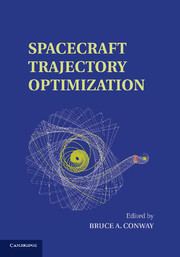Book contents
- Frontmatter
- Contents
- Preface
- 1 The Problem of Spacecraft Trajectory Optimization
- 2 Primer Vector Theory and Applications
- 3 Spacecraft Trajectory Optimization Using Direct Transcription and Nonlinear Programming
- 4 Elements of a Software System for Spacecraft Trajectory Optimization
- 5 Low-Thrust Trajectory Optimization Using Orbital Averaging and Control Parameterization
- 6 Analytic Representations of Optimal Low-Thrust Transfer in Circular Orbit
- 7 Global Optimization and Space Pruning for Spacecraft Trajectory Design
- 8 Incremental Techniques for Global Space Trajectory Design
- 9 Optimal Low-Thrust Trajectories Using Stable Manifolds
- 10 Swarming Theory Applied to Space Trajectory Optimization
- Index
- References
4 - Elements of a Software System for Spacecraft Trajectory Optimization
Published online by Cambridge University Press: 06 December 2010
- Frontmatter
- Contents
- Preface
- 1 The Problem of Spacecraft Trajectory Optimization
- 2 Primer Vector Theory and Applications
- 3 Spacecraft Trajectory Optimization Using Direct Transcription and Nonlinear Programming
- 4 Elements of a Software System for Spacecraft Trajectory Optimization
- 5 Low-Thrust Trajectory Optimization Using Orbital Averaging and Control Parameterization
- 6 Analytic Representations of Optimal Low-Thrust Transfer in Circular Orbit
- 7 Global Optimization and Space Pruning for Spacecraft Trajectory Design
- 8 Incremental Techniques for Global Space Trajectory Design
- 9 Optimal Low-Thrust Trajectories Using Stable Manifolds
- 10 Swarming Theory Applied to Space Trajectory Optimization
- Index
- References
Summary
Introduction
This chapter presents the main elements associated with a general spacecraft trajectory design and optimization software system. A unified framework is described that facilitates the modeling and optimization of spacecraft trajectories that may operate in complex gravitational force fields, use multiple propulsion systems, and involve multiple spacecraft. The ideas presented are simple and practical and are based in part on the existing wealth of knowledge documented in the open literature and the author's experience in developing software systems of this type.
The goal of any general trajectory design and optimization system is to facilitate the solution to a wide range of problems in a robust and efficient manner. A trade off exists between scope and depth. An attempt is made to strike a balance between the two and describe an approach that has proven to be robust and useful for a broad range of spacecraft trajectory design problems. The ideas and techniques presented here have been implemented in a working operational system known as Copernicus. This system has been used to support the detailed and comprehensive mission design studies associated with NASA's Constellation program. It has also been used to design and optimize the LCROSS mission trajectory which was launched on June 18, 2009.
Information
- Type
- Chapter
- Information
- Spacecraft Trajectory Optimization , pp. 79 - 111Publisher: Cambridge University PressPrint publication year: 2010
References
Accessibility standard: Unknown
Why this information is here
This section outlines the accessibility features of this content - including support for screen readers, full keyboard navigation and high-contrast display options. This may not be relevant for you.Accessibility Information
- 3
- Cited by
